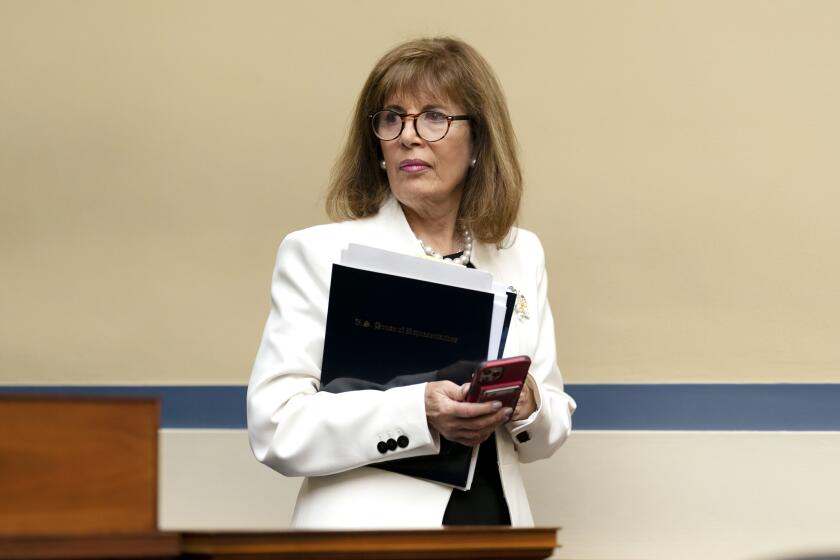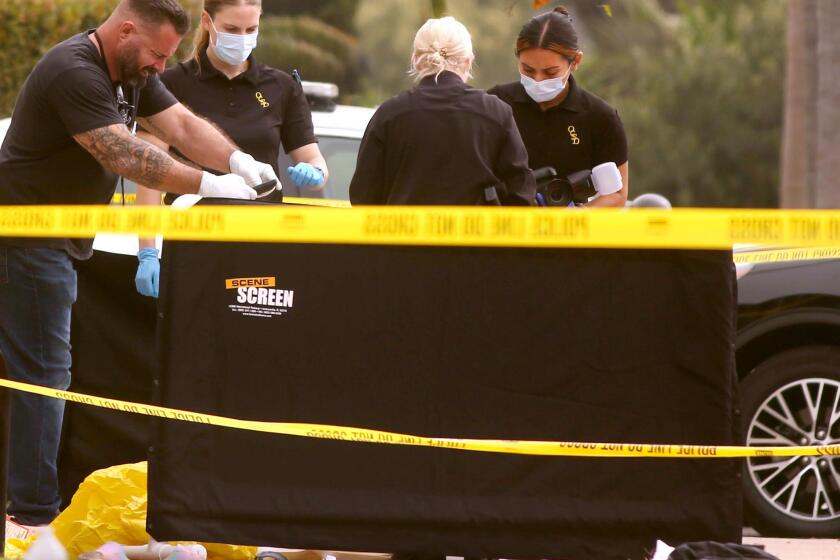Age could be key part of hit-and-run trial
Jailhouse birthdays for Helen Golay and Olga Rutterschmidt, accused of staging the hit-and-run deaths of two homeless men, quietly came and went uncelebrated this year. Golay turned 77 in February and Rutterschmidt became 75 this month.
But age could be a key factor in a trial set to begin this week before a three-woman, nine-man jury, who will determine the fate of the two women who prosecutors allege conspired to kill the men and collected nearly $3 million in life insurance claims. Opening statements are expected to start Tuesday.
The unusual age of the defendants, who face life without the possibility of parole if convicted, will be a “double-edged sword” in the case, said Laurie Levenson, a Loyola Law School professor and former federal prosecutor.
Although jurors might be sympathetic to the petite, aging women, their ages also leave little possibility for a plea deal with prosecutors, Levenson said.
In a plea agreement, “the government would usually want some jail time, but giving them any jail time is giving them a life sentence,” she said. “There isn’t as much wiggle room.”
Prosecutors decided last year not to seek the death penalty. Because capital punishment appeals take a minimum of 10 years, the women could die in prison before any decision was reached.
“They’re not likely to get the death penalty on little old ladies. . . . Seeking the death penalty, you don’t gain anything,” Levenson said.
But the district attorney’s office said the women’s age would not be an issue in the trial. “It’s not the age that counts, it’s what they do. And we intend to show in court what their actions were,” said spokeswoman Sandi Gibbons, noting that people of similar ages have been convicted in murder trials.
“Their being female and of that age certainly raises your eyebrows,” said Det. Dennis Kilcoyne of the Los Angeles Police Department, the chief investigator in the case.
Golay’s attorney, Roger Diamond, said his client was innocent and no attempt was made to strike a deal.
Diamond said he had a defense of “dynamite nature” that would prove no murder ever took place, but would not elaborate. Rutterschmidt’s attorney, public defender Michael Sklar, declined to comment.
In a case that has drawn the attention of legal experts and moviemakers, prosecutors allege that the women befriended the homeless men, put them up in apartments and hired security guards to keep an eye on them before staging their deaths.
Paul Vados, 73, and Kenneth McDavid, 50, were both killed in apparent hit-and-run incidents in 1999 and 2005, respectively. Vados was covered by more than a dozen life insurance policies, and McDavid by 23. Rutterschmidt and Golay claimed the bodies under the pretense of being relatives or associates of the men, and collected the insurance payments, authorities say.
In a pretrial hearing last week, prosecutors said they would present to the jury photos of the victims’ bodies, which show the two men suffered similar wounds to the upper part of the body. Prosecutors said they would argue that lacerations on the head, hand and upper torso indicate that the men were lying on the street when they were struck, rather than being hit in a typical collision, which would have caused injuries to the legs.
“This victim was laid down and run over,” Deputy Dist. Atty. Truc Do said of McDavid at the hearing.
Authorities believe McDavid was run over by a 1999 Mercury Sable that the women had bought under a fake name. That vehicle, in which authorities say human tissue and clumps of hair were found with McDavid’s DNA in the undercarriage, will be brought to the courthouse parking lot for the jurors to view. Prosecutors also will present photos from Golay’s apartment showing empty vials for prescription drugs. An autopsy found three types of chemicals and alcohol in McDavid’s blood.
Another key piece of possible evidence for the prosecution is a surreptitious recording of a conversation between Golay and Rutterschmidt when they were arrested. The women were left in a room at LAPD headquarters with a video camera documenting their exchange, which prosecutors believe to be incriminating.
Diamond, Golay’s attorney, filed a motion Friday to preclude the recording, arguing that proper procedures were not followed in the arrest by FBI agents.
According to segments of the conversation cited in the motion, Rutterschmidt mentioned Vados -- one of the victims -- and said to Golay, “Why did you make all these . . . extra insurances?”
“You were greedy. That is the problem. That’s why I get angry. . . . I was doing everything for you,” Rutterschmidt was quoted as saying.
Since they have been jailed, the women have been housed separately and are not allowed to converse.
To demonstrate how the alleged scheme worked, the government will call as a witness Jimmy Covington, another transient whom authorities believe the pair targeted. After Golay and Rutterschmidt were arrested in 2006, police located three men for whom the women allegedly tried to buy life insurance policies. All of the men are alive, Kilcoyne said.
The women appeared in court last week for pretrial hearings and jury selection looking somber. Only a hint was left of the dye that once concealed the graying of the women’s hair. Rutterschmidt squirmed and complained to her lawyer that she felt sick, while Golay appeared calm.
Diamond said he repeatedly asked for considerations for his client because of her age. Golay finally was given thermal underwear and a special diet because of her high blood pressure.
More to Read
Start your day right
Sign up for Essential California for news, features and recommendations from the L.A. Times and beyond in your inbox six days a week.
You may occasionally receive promotional content from the Los Angeles Times.






